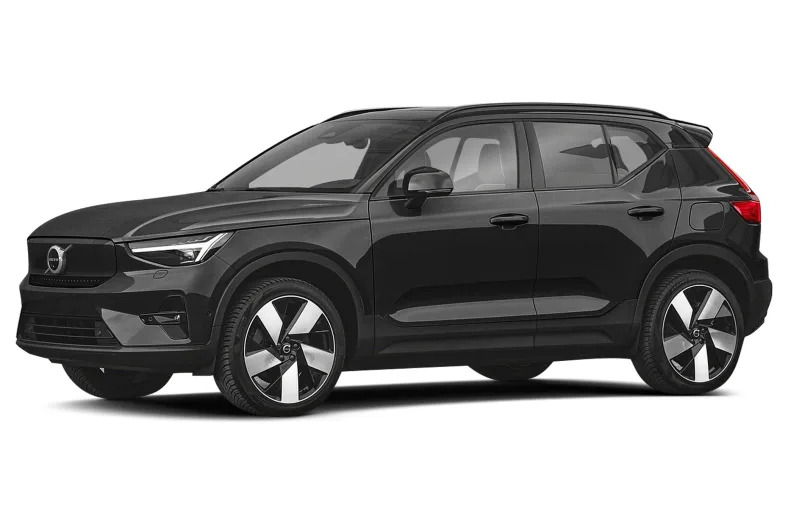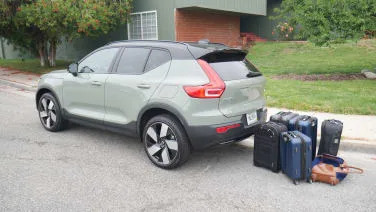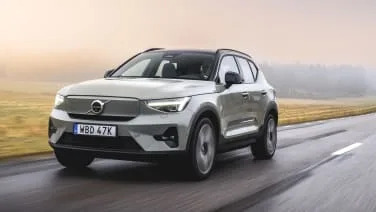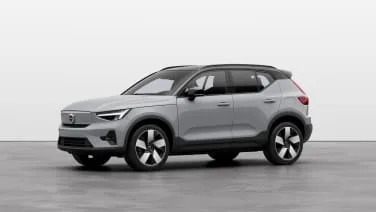Twin Core 4dr All-Wheel Drive Sport Utility
2023 Volvo XC40 Recharge Pure Electric

Industry
The 2024 Volvo XC40 Recharge and C40 EVs will be available with rear-wheel drive, replacing the front-wheel-drive version that has been the fraternal pairing’s single-motor base model. This is obviously newsworthy — why else would I be writing about it? But does it actually mean anything? After driving both of these vehicles around the lakes, seaside, perfectly-maintained highways, and cobblestoned urban streets proximate to the brand’s headquarters in Gothenburg, Sweden, I can say that the answer is, not really. But that’s not really Volvo’s fault. The last time Volvo sold a rear-wheel-drive vehicle in the United States was 1998 when the cushy, brick-like 960 was retired (officially S90 and V90 in their final year). Everything thereafter was front-wheel drive or at least on a front-drive-based platform, in no small part due to the additional all-weather traction and stability afforded by the additional weight of an internal combustion engine and transaxle over the drive wheels. In short, it was safer, and even as Volvo moved away from decades of arcane, rectilinear design, safety remained its raison d’etre. That hasn’t changed, but according to Volvo, EVs have fundamentally changed vehicle dynamics, centers of gravity, and weight distribution to refute the front-drive argument. A Volvo spokesperson told me that this new one-motor layout in the XC/C40, driving the rear wheels, with contemporary advanced driver assistance systems, is better in inclement weather than a gas-engine/FWD combo. That explains why the switch to a standard rear-drive layout doesn’t run afoul of Volvo’s established ethos, but why make the switch in the first place? Whether it was the plan all along, or just an advancement of next-generation technology to prolong and extend the relevance of these vehicles, is not something Volvo would comment on. In any event, many of the base EVs that are in or near the XC/C40’s competitive set — the VW ID.4, the Kia EV6, the Hyundai Ioniq 5 — feature rear-wheel drive in their single-motor setup. It is notable that all of those cars were developed from the ground up as EVs and could be optimized for the aforementioned dynamics. The XC40 and C40 were built on a platform capable of accommodating gas-only, plug-in hybrid and full-electric powertrains. It's also important to note that with this switch in standard layout comes new motors, which may have something to do with the switch. They were also developed in-house, optimizing Volvo's efficiencies, rather than purchasing its needs from a supplier. This is not something a carmaker does with a part they are using simply to extend the life of a vehicle nearing replacement. This new rear motor is thus likely to find other uses down the line. Volvo spokespeople would not comment on future product offerings, but I would hazard to bet that versions of this motor mounted to the rear axle will proliferate through the Volvo range as its pure electric offerings expand in its next generation(s) of vehicles. (Volvo has promised to build only battery-powered passenger vehicles by 2030). We didn’t …
Full Review
The 2024 Volvo XC40 Recharge and C40 EVs will be available with rear-wheel drive, replacing the front-wheel-drive version that has been the fraternal pairing’s single-motor base model. This is obviously newsworthy — why else would I be writing about it? But does it actually mean anything? After driving both of these vehicles around the lakes, seaside, perfectly-maintained highways, and cobblestoned urban streets proximate to the brand’s headquarters in Gothenburg, Sweden, I can say that the answer is, not really. But that’s not really Volvo’s fault. The last time Volvo sold a rear-wheel-drive vehicle in the United States was 1998 when the cushy, brick-like 960 was retired (officially S90 and V90 in their final year). Everything thereafter was front-wheel drive or at least on a front-drive-based platform, in no small part due to the additional all-weather traction and stability afforded by the additional weight of an internal combustion engine and transaxle over the drive wheels. In short, it was safer, and even as Volvo moved away from decades of arcane, rectilinear design, safety remained its raison d’etre. That hasn’t changed, but according to Volvo, EVs have fundamentally changed vehicle dynamics, centers of gravity, and weight distribution to refute the front-drive argument. A Volvo spokesperson told me that this new one-motor layout in the XC/C40, driving the rear wheels, with contemporary advanced driver assistance systems, is better in inclement weather than a gas-engine/FWD combo. That explains why the switch to a standard rear-drive layout doesn’t run afoul of Volvo’s established ethos, but why make the switch in the first place? Whether it was the plan all along, or just an advancement of next-generation technology to prolong and extend the relevance of these vehicles, is not something Volvo would comment on. In any event, many of the base EVs that are in or near the XC/C40’s competitive set — the VW ID.4, the Kia EV6, the Hyundai Ioniq 5 — feature rear-wheel drive in their single-motor setup. It is notable that all of those cars were developed from the ground up as EVs and could be optimized for the aforementioned dynamics. The XC40 and C40 were built on a platform capable of accommodating gas-only, plug-in hybrid and full-electric powertrains. It's also important to note that with this switch in standard layout comes new motors, which may have something to do with the switch. They were also developed in-house, optimizing Volvo's efficiencies, rather than purchasing its needs from a supplier. This is not something a carmaker does with a part they are using simply to extend the life of a vehicle nearing replacement. This new rear motor is thus likely to find other uses down the line. Volvo spokespeople would not comment on future product offerings, but I would hazard to bet that versions of this motor mounted to the rear axle will proliferate through the Volvo range as its pure electric offerings expand in its next generation(s) of vehicles. (Volvo has promised to build only battery-powered passenger vehicles by 2030). We didn’t …
Hide Full Review
Hide Full Review
Retail Price
$53,550
MSRP / Window Sticker Price
| Engine | |
| MPG | 92 City / 79 Hwy |
| Seating | 5 Passengers |
| Transmission | 1-spd |
| Power | 402 @ 13900 rpm |
| Drivetrain | Instant Traction all wheel |
Smart Buy Program is powered by 





